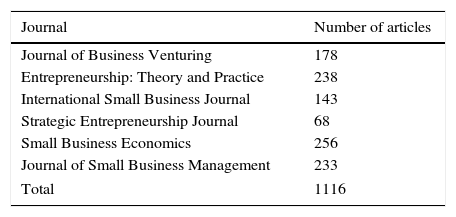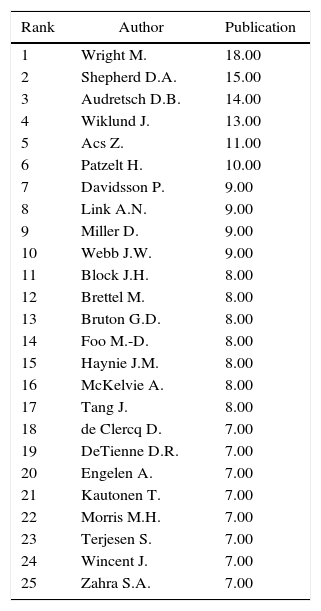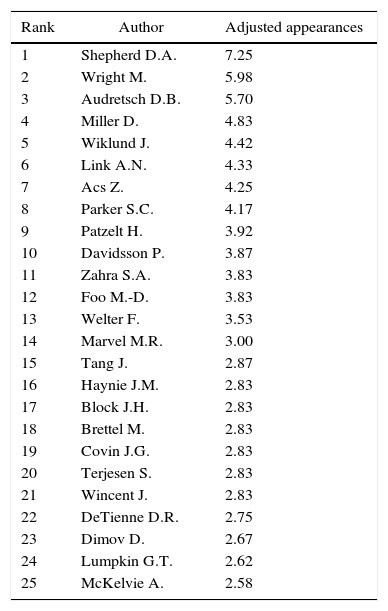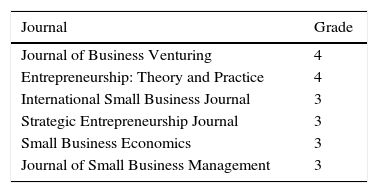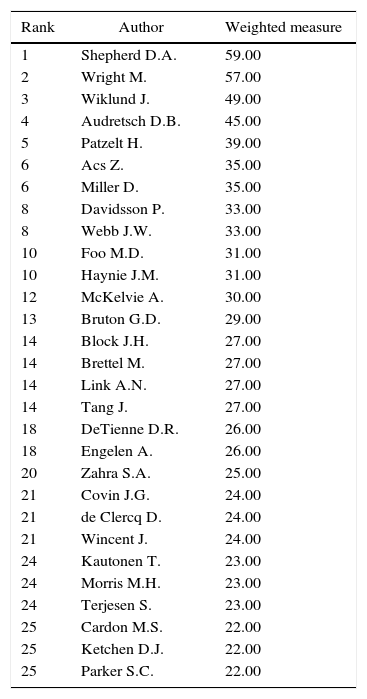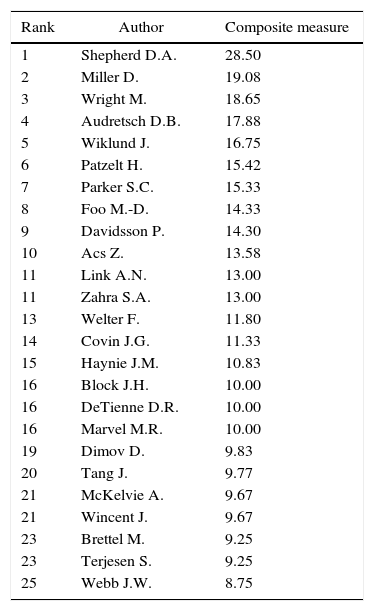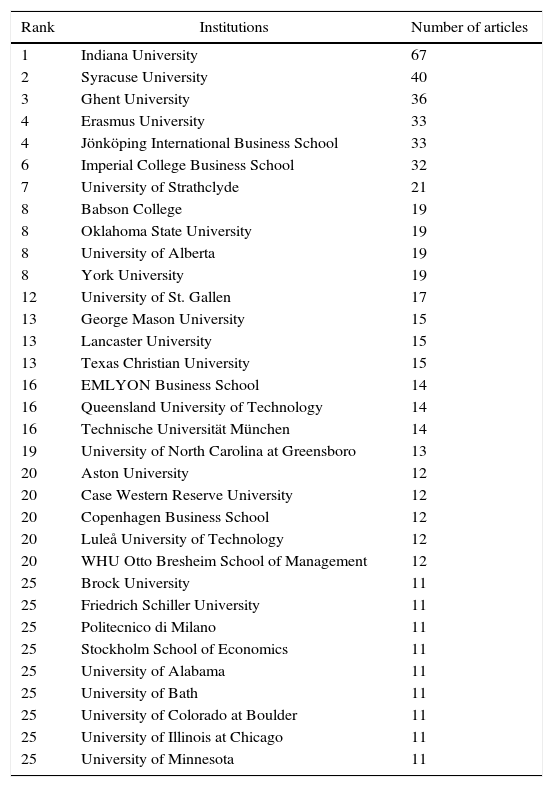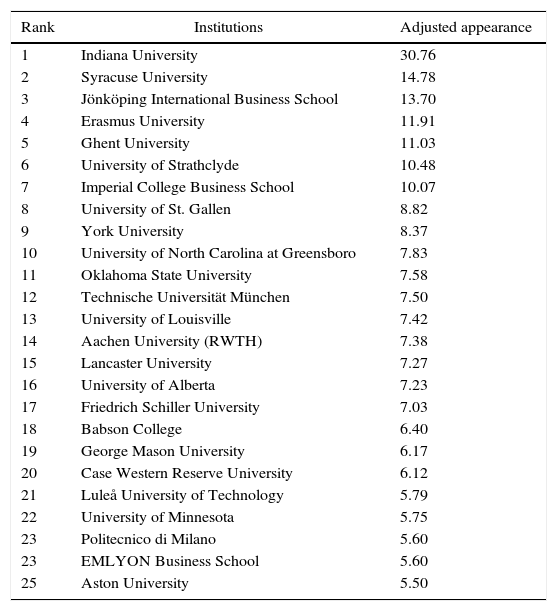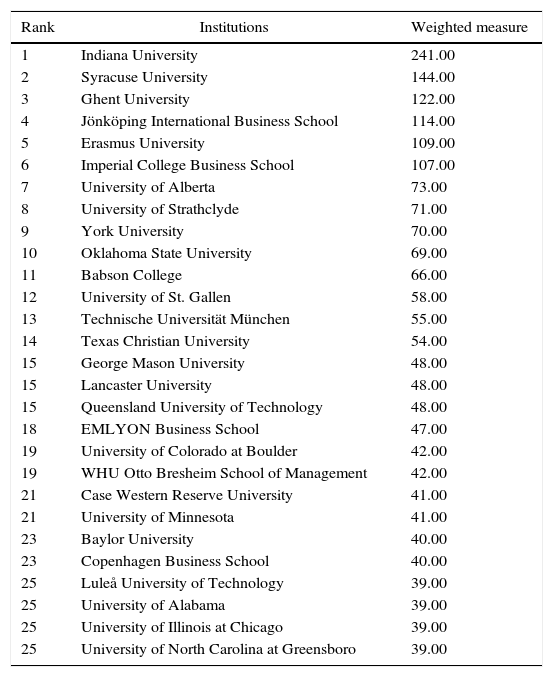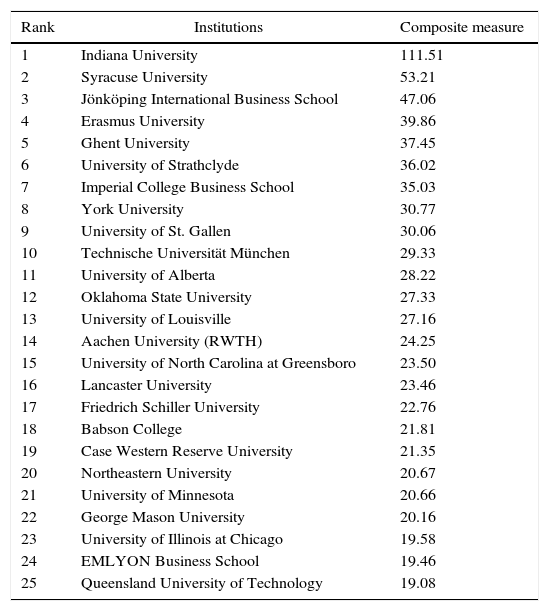Given the considerable increase in entrepreneurship scholarship in the form of journal outlets, article publications, and university positions, it is important to identify the authors leading the charge to push the academic field forward. In this article, we provide an in-depth impact analysis of authors and their universities in terms of publishing high quality entrepreneurship research in leading entrepreneurship journals. Our analysis covers contributions made from 2011 to 2015 in the top six entrepreneurship-focused outlets. Study findings and implications are discussed.
Debido al aumento en estudios de emprendimiento en revistas, artículos, y opiniones universitarias, es importante identificar a los autores que están al frente de avanzar este ámbito académico. En este artículo, analizamos el impacto de los autores y sus universidades en cuanto a sus publicaciones destacadas de estudios de emprendimiento en revistas académicas prominentes. Este análisis incluye artículos en las seis mejores revistas de emprendimiento escritos entre el año 2011 y el 2015. Se discuten los resultados del estudio y sus implicaciones.
Based on the growth of the field of entrepreneurship as an academic discipline, several scholars have offered various assessments of contributions made to the field. For example, Shane (1997) examined the publications of authors and institutions in the field's formative years. Gregoire, Noel, Déry, and Béchard (2006) analyzed the degree of conceptual convergence in the field through a co-citation examination. Other studies of scholarship contributions include investigation of family business research impact to entrepreneurship (Debicki, Matherne, Kellermanns, & Chrisman, 2009) and cross-disciplinary influences (Ireland & Webb, 2007). Most recently, Gupta, Ibrahim, Guo, and Markin (2016) provide insights into the top authors and institutions of entrepreneurial topics in leading management journals. Thus, interest in the “who's who” of entrepreneurship research continues to increase as academics and practitioners alike look to leading voices to guide and push the field of study forward.
Reviewing the contributions within a discipline permits evaluation of the field's current state and aids in the development of future research agendas. Specifically, identifying the most influential scholars provides insight into our field's thought leaders who have made major theoretical or empirical contributions. Likewise, evaluating author and institution contributions can illuminate the benefits of diversity among a community of researchers and may offer an explanation of the rapid growth in the field. These assessments often form the basis of rankings which as “the catalyst(s) of change,” are highly coveted by business school administrators and faculty (Walsh, Tushman, Kimberly, Starbuck, & Ashford, 2007: 130). Given the importance of identifying these thought leaders, the purpose of this study is to provide a current assessment of author and institutional scholarly contributions to the field of entrepreneurship. While others have completed similar assessments, our approach focuses specifically on contributions made in leading entrepreneurship journals. Certainly identifying contributions to a broader field of management through analysis of top-tiered management journals is useful. However, it is our contention that entrepreneurship field journals more accurately reflect the state of entrepreneurship scholarship and take greater care to consider practitioner, consultant, and policy impacts. That is, specific entrepreneurship journals do not necessarily have to coexist with other management disciplines and are therefore contributed to, and read by, a greater and more dispersed number of entrepreneurship scholars than comprehensive management outlets. We also evaluate the quality of the publication outlet by reviewing which journals provide the greatest average impact in order to be as comprehensive as possible on overall impact of the entrepreneurship field all provided through a contribution-based approach.
The results of 1116 articles depict a diverse scholarly community represented by some 1907 individuals and 976 institutions of research from nearly every continent across the globe. Such diversity provides the field with many different perspectives and encourages debate among members. The recognition of the highest producing authors and institutions serves multiple purposes (Diener, Oishi, & Park, 2014). First, from an educational perspective, it may aid institutions in promoting their superior talent and program specialties, as well as students seeking admittance into such programs. Entrepreneurship is a professional career option and vital to all aspects of economic growth. As such, people seeking such a profession require training and education in matters of risk management, innovation, and other entrepreneurial specifics (Giacomin et al., 2011). Second, administratively, institutions and researchers may use studies such as this for topics related to faculty recognition, tenure, promotion, and hiring decisions. Third, scholars may use this study as a metric for evaluating their own efforts in scholarly activity and obtain a better understanding of what the top producers in the field are doing. This study proceeds with a brief overview of the conceptual drivers of a contribution-based approach to analyzing an academic field. Next, we outline the study's methodology and present results. We conclude with a discussion of the findings and implications of our work.
Conceptual frameworkReviewing the contributions within a discipline permits a better evaluation of the field's current state and aids in the development of future research agendas. Naming specific researchers and their representative institutions are two such methods for evaluating the state of research in the field of evaluation. Such inquiry can illuminate the benefits of diversity among a community of researchers and may offer an explanation of the rapid growth in the field. Such rankings among business schools have been proposed as “the catalyst of change,” and is a title that deans and faculty often hold in high regard (Walsh et al., 2007: 130). As we will show, the community is represented by some 1907 individuals and 976 institutions of research from nearly every continent across the globe. Such diversity provides the field with many different perspectives and thus encourages debate among members.
Entrepreneurship research is concerned with the study of “sources of opportunities; the processes of discovery, evaluation, and exploitation of opportunities; and the set of individuals who discover, evaluate, and exploit them (Shane & Venkataraman, 2000, p. 218). Based on widespread acceptance of the economic benefits of entrepreneurship, the field of entrepreneurship has had little trouble growing and gaining prominence. Compared to other fields of study in both business and management specifically, the academic field of entrepreneurship is still somewhat new. From its earliest conceptions, entrepreneurial study has relied on instrumental scholarly leaders to provoke interest and promote the field as a distinct and legitimate area of research. Early pioneers of the discipline included Joseph Schumpeter (1934) who highlighted the importance of entrepreneurs as innovators and change agents in economies and McClelland's (1967) insights into the entrepreneurial mind. Kirzner (1973) proposed his ideas regarding the discovery of entrepreneurial opportunities. Birch (1979) and Peter Drucker (1985) pushed entrepreneurship scholarship boundaries and helped develop entrepreneurship as a strategic focus of organizations. More recently, the field has taken a giant leap forward as Shane and Venkataraman (2000) articulated the specific foci and boundaries of studies in entrepreneurship.
Grounded in the efforts of these scholarly leaders, entrepreneurship research continues to grow in prominence in the academic community. Academic journals based in several different continents publish the work of entrepreneurship scholars from numerous countries and hundreds of universities (Shane, 1997). Contributing the rigor of the field, these scholars increasingly offer new theoretical ideas and empirically sophisticated analyses thereby continually pushing entrepreneurship into a recognized field of research and expanding our base of knowledge. Against this backdrop, we draw on a “contribution-based approach” for examining the contemporary leaders in the field of entrepreneurship.
Morrison and Inkpen (1991) described a “contribution-based approach” as a way of assessing scholarly output by measuring contributions to top-tier journals. The power of this approach provides a manageable focus, relative objectivity, and can be easily compared with previous reviews (e.g. Shane, 1997). The contribution-based approach has found favor among scholars in management research (Podsakoff, MacKenzie, Podsakoff, & Bachrach, 2008), as well as specific management fields such as entrepreneurship (Gupta et al., 2016), family business (Debicki et al., 2009), and international business (Morrison & Inkpen, 1991). As such, we draw on the contribution-based approach in assessing entrepreneurship scholarly output.
Methodology and resultsIn this study we utilize a systematic approach to identify the top researchers and institutions within the field of entrepreneurship by reviewing articles published in leading entrepreneurship journals. Focusing on recent publications (i.e., the last five years, 2011–2015) enables us to gauge the present-day status of the field's contributors and highlight the top institutions supporting such advances. While prior studies often excluded discipline-specific journals (Gupta et al., 2016; Shane, 1997), we chose to focus on these neglected journals by following a similar methodological approach. We identified and evaluated articles covering topics and keywords associated with entrepreneurship published in six academic journals. The journals examined for this study were Journal of Business Venturing, Entrepreneurship: Theory and Practice, International Small Business Journal, Small Business Economics, Strategic Entrepreneurship Journal, and Journal of Small Business Management. These journals represent the elite field-level outlets in the entrepreneurship domain (Carraher & Paridon, 2015; Fayolle & Wright, 2014; Fried, 2003; Stewart & Cotton, 2013). Because studies of journals covering broader topics in the management field (i.e. ASQ, SMJ, etc.) have been examined elsewhere (Gupta et al., 2016; Shane, 1997), we have excluded them from this study in favor of entrepreneurship-specific journals.
The five-year time frame (January, 2011 to December, 2015) for this study was chosen for the following reasons. First, many institutions across the globe have recently begun to fund centers dedicated to research and service on entrepreneurship, as well as the development of graduate programs offering masters and doctorate level degrees (Cassia, De Massis, Meoli, & Minola, 2014; Morris, Kuratko, & Pryor, 2014), thus furthering growth. Second, given such institutional interest in entrepreneurship, potential entrepreneurship students, and graduates of recently formed programs, it is of great interest to the field to see what schools and researchers are contributing the most to the literature within this timeframe. Third, Bazeley (2003: 274), offers a definition of an ‘early career’ researcher as “…one who is currently within their first five years of academic or other research-related employment allowing uninterrupted, stable research development following completion of their postgraduate research training.” We believe providing a snapshot of the last 5 years will be beneficial to ‘early career’ researchers as they are most likely facing tenure and promotion review.
The Scopus database was used to access the articles published in the selected journals. While the selected journals represent the domain of entrepreneurship in general (Carraher & Paridon, 2015), we wanted to ensure that the articles themselves were of an entrepreneurial-specific nature. Following previous work (Busenitz et al., 2003; Gupta et al., 2016) we searched and selected articles that used keywords in their title or abstract related to entrepreneurship, such as: entrepreneur/entrepreneurship/entrepreneurial/small business/emerging business/new venture/emerging venture/founder(s). We reviewed a total of 1595 articles and selected articles accordingly based on the aforementioned criteria. Of that total, 1116 (∼70%) articles were selected for this study. The selection process was based on both visual analysis and a redundant computer aided search of the keywords mentioned above. Any discrepancies among the coders were discussed and decided on by majority vote. Table 1 shows the distribution of entrepreneurship articles by journal.
Distribution of articles in journals.
| Journal | Number of articles |
|---|---|
| Journal of Business Venturing | 178 |
| Entrepreneurship: Theory and Practice | 238 |
| International Small Business Journal | 143 |
| Strategic Entrepreneurship Journal | 68 |
| Small Business Economics | 256 |
| Journal of Small Business Management | 233 |
| Total | 1116 |
In line with the global academic and economic interest in entrepreneurship, we find that the list of researchers is represented by a diverse set of individuals from all reaches of the world. 1907 individual researchers from 976 institutions have either solely or collaboratively contributed to the more than 1100 articles of this study. These results differ with the results of Gupta et al. (2016: 71), that found a total of 371 entrepreneurship articles among 7 top management journals, and “a total number of 618 authors from 303 different institutions” over a 16 year period. The present study reported over three-times the number of researchers and articles being published in entrepreneurship specific journals rather than the mainstream publications in nearly a third of the timeframe.
Author impactFollowing Shane's (1997) methodology, we utilized four measures of author impact. The first simply measures the number of articles published by the researchers among the six journals selected from 2011 to 2015. Table 2 displays the top 25 ranking authors, as ranked by publication count. Authors having the same number of publications share rank position. The second measure ranked authors based on the adjusted number of appearances in the articles selected for study. This measure controls for large numbers of publications by authors who write with multiple coauthors (Shane, 1997). For each article published, we assigned a score of one to each author for sole-authored papers, one-half for each author of a paper penned by two authors, one-third for those penned by three authors, and so on (Morrison & Inkpen, 1991). This method has been used by others in previous research (Gupta et al., 2016; Heck & Cooley, 1988; Morrison & Inkpen, 1991; Shane, 1997). Table 3 shows the top 25 authors ranked by adjusted number of appearances in the entrepreneurship articles published among the listed journals from 2011 to 2015.
Author rank by publication.
| Rank | Author | Publication |
|---|---|---|
| 1 | Wright M. | 18.00 |
| 2 | Shepherd D.A. | 15.00 |
| 3 | Audretsch D.B. | 14.00 |
| 4 | Wiklund J. | 13.00 |
| 5 | Acs Z. | 11.00 |
| 6 | Patzelt H. | 10.00 |
| 7 | Davidsson P. | 9.00 |
| 8 | Link A.N. | 9.00 |
| 9 | Miller D. | 9.00 |
| 10 | Webb J.W. | 9.00 |
| 11 | Block J.H. | 8.00 |
| 12 | Brettel M. | 8.00 |
| 13 | Bruton G.D. | 8.00 |
| 14 | Foo M.-D. | 8.00 |
| 15 | Haynie J.M. | 8.00 |
| 16 | McKelvie A. | 8.00 |
| 17 | Tang J. | 8.00 |
| 18 | de Clercq D. | 7.00 |
| 19 | DeTienne D.R. | 7.00 |
| 20 | Engelen A. | 7.00 |
| 21 | Kautonen T. | 7.00 |
| 22 | Morris M.H. | 7.00 |
| 23 | Terjesen S. | 7.00 |
| 24 | Wincent J. | 7.00 |
| 25 | Zahra S.A. | 7.00 |
Author rank by adjusted appearances.
| Rank | Author | Adjusted appearances |
|---|---|---|
| 1 | Shepherd D.A. | 7.25 |
| 2 | Wright M. | 5.98 |
| 3 | Audretsch D.B. | 5.70 |
| 4 | Miller D. | 4.83 |
| 5 | Wiklund J. | 4.42 |
| 6 | Link A.N. | 4.33 |
| 7 | Acs Z. | 4.25 |
| 8 | Parker S.C. | 4.17 |
| 9 | Patzelt H. | 3.92 |
| 10 | Davidsson P. | 3.87 |
| 11 | Zahra S.A. | 3.83 |
| 12 | Foo M.-D. | 3.83 |
| 13 | Welter F. | 3.53 |
| 14 | Marvel M.R. | 3.00 |
| 15 | Tang J. | 2.87 |
| 16 | Haynie J.M. | 2.83 |
| 17 | Block J.H. | 2.83 |
| 18 | Brettel M. | 2.83 |
| 19 | Covin J.G. | 2.83 |
| 20 | Terjesen S. | 2.83 |
| 21 | Wincent J. | 2.83 |
| 22 | DeTienne D.R. | 2.75 |
| 23 | Dimov D. | 2.67 |
| 24 | Lumpkin G.T. | 2.62 |
| 25 | McKelvie A. | 2.58 |
Journal quality is an important aspect of the publication and an author's scholarly impact. We address this issue by employing a third measure that accounts for journal quality. Following the grading scheme of Fayolle and Wright (2014), we rate the articles published in the six journals based on their quality (4 being the highest and 1 being the lowest). The grade rating for each journal is provided in Table 4. As the journals selected are regarded as top outlets in the field, the grade range represented here is only between 3 and 4.
Journal quality grade (Fayolle & Wright, 2014).
| Journal | Grade |
|---|---|
| Journal of Business Venturing | 4 |
| Entrepreneurship: Theory and Practice | 4 |
| International Small Business Journal | 3 |
| Strategic Entrepreneurship Journal | 3 |
| Small Business Economics | 3 |
| Journal of Small Business Management | 3 |
The third measure of author impact gives consideration to the quality weights given to each journal. As such, this weighted appearances measure is calculated by taking the numerical grade rating for each journal in which the articles were published and summing them by author (Shane, 1997). Table 5 shows the top 25 authors by rank according to the weights given to each article published in the listed journals.
Author rank by weighted measure.
| Rank | Author | Weighted measure |
|---|---|---|
| 1 | Shepherd D.A. | 59.00 |
| 2 | Wright M. | 57.00 |
| 3 | Wiklund J. | 49.00 |
| 4 | Audretsch D.B. | 45.00 |
| 5 | Patzelt H. | 39.00 |
| 6 | Acs Z. | 35.00 |
| 6 | Miller D. | 35.00 |
| 8 | Davidsson P. | 33.00 |
| 8 | Webb J.W. | 33.00 |
| 10 | Foo M.D. | 31.00 |
| 10 | Haynie J.M. | 31.00 |
| 12 | McKelvie A. | 30.00 |
| 13 | Bruton G.D. | 29.00 |
| 14 | Block J.H. | 27.00 |
| 14 | Brettel M. | 27.00 |
| 14 | Link A.N. | 27.00 |
| 14 | Tang J. | 27.00 |
| 18 | DeTienne D.R. | 26.00 |
| 18 | Engelen A. | 26.00 |
| 20 | Zahra S.A. | 25.00 |
| 21 | Covin J.G. | 24.00 |
| 21 | de Clercq D. | 24.00 |
| 21 | Wincent J. | 24.00 |
| 24 | Kautonen T. | 23.00 |
| 24 | Morris M.H. | 23.00 |
| 24 | Terjesen S. | 23.00 |
| 25 | Cardon M.S. | 22.00 |
| 25 | Ketchen D.J. | 22.00 |
| 25 | Parker S.C. | 22.00 |
The fourth measure of author impact takes into account the number of coauthors and journal quality, as this may affect the scholarly contribution. Again, following Shane (1997), we use the grade rating of journal quality and the authors’ contribution percentage to arrive at a composite measure. To calculate the composite measure, we first divided the journal grade rating by the number of authors and then summed these scores for each scholar (Shane, 1997). Table 6 shows the ranking of the top 25 authors among the journals listed from 2011 to 2015.
Author rank by composite measure.
| Rank | Author | Composite measure |
|---|---|---|
| 1 | Shepherd D.A. | 28.50 |
| 2 | Miller D. | 19.08 |
| 3 | Wright M. | 18.65 |
| 4 | Audretsch D.B. | 17.88 |
| 5 | Wiklund J. | 16.75 |
| 6 | Patzelt H. | 15.42 |
| 7 | Parker S.C. | 15.33 |
| 8 | Foo M.-D. | 14.33 |
| 9 | Davidsson P. | 14.30 |
| 10 | Acs Z. | 13.58 |
| 11 | Link A.N. | 13.00 |
| 11 | Zahra S.A. | 13.00 |
| 13 | Welter F. | 11.80 |
| 14 | Covin J.G. | 11.33 |
| 15 | Haynie J.M. | 10.83 |
| 16 | Block J.H. | 10.00 |
| 16 | DeTienne D.R. | 10.00 |
| 16 | Marvel M.R. | 10.00 |
| 19 | Dimov D. | 9.83 |
| 20 | Tang J. | 9.77 |
| 21 | McKelvie A. | 9.67 |
| 21 | Wincent J. | 9.67 |
| 23 | Brettel M. | 9.25 |
| 23 | Terjesen S. | 9.25 |
| 25 | Webb J.W. | 8.75 |
Shane's (1997) assumed that the four measures of author impact employed may favor some scholars over others based on publication outlet and co-authorship. Hence, the four measures may be considered as accurate if they returned similar rankings (Shane, 1997). Spearman's rank correlations of the measures was used to test for convergent validity. Significant convergent validity across the measures indicates the absence of bias. Table 7 displays the correlations across all authors of entrepreneurship articles found in the listed journals from 2011 to 2015.
Institutional impactAlongside the scholarly works of researchers, we consider the credit that must be given to the scholarly impact of the institutions that house them. To measure this impact, we chose to follow the same measures introduced above for individual researchers. Following Shane's (1997) methodology, our first measure ranks institutions based on the number of articles published by their faculty in the six selected journals from 2011 to 2015. Table 8 shows the top 25 institutions based on number of publications.
Institution rank by publications.
| Rank | Institutions | Number of articles |
|---|---|---|
| 1 | Indiana University | 67 |
| 2 | Syracuse University | 40 |
| 3 | Ghent University | 36 |
| 4 | Erasmus University | 33 |
| 4 | Jönköping International Business School | 33 |
| 6 | Imperial College Business School | 32 |
| 7 | University of Strathclyde | 21 |
| 8 | Babson College | 19 |
| 8 | Oklahoma State University | 19 |
| 8 | University of Alberta | 19 |
| 8 | York University | 19 |
| 12 | University of St. Gallen | 17 |
| 13 | George Mason University | 15 |
| 13 | Lancaster University | 15 |
| 13 | Texas Christian University | 15 |
| 16 | EMLYON Business School | 14 |
| 16 | Queensland University of Technology | 14 |
| 16 | Technische Universität München | 14 |
| 19 | University of North Carolina at Greensboro | 13 |
| 20 | Aston University | 12 |
| 20 | Case Western Reserve University | 12 |
| 20 | Copenhagen Business School | 12 |
| 20 | Luleå University of Technology | 12 |
| 20 | WHU Otto Bresheim School of Management | 12 |
| 25 | Brock University | 11 |
| 25 | Friedrich Schiller University | 11 |
| 25 | Politecnico di Milano | 11 |
| 25 | Stockholm School of Economics | 11 |
| 25 | University of Alabama | 11 |
| 25 | University of Bath | 11 |
| 25 | University of Colorado at Boulder | 11 |
| 25 | University of Illinois at Chicago | 11 |
| 25 | University of Minnesota | 11 |
The second measure of institutional impact takes into account the potential for bias that may occur from having multiple authors representing one institution. To control for this, we ranked institutions based on the number of appearances in the selected journals adjusting for the number of authors per article. Following previous research in institutional impact, for each article selected, a score of one was given to an institution represented by a single-author publication, one-half for those articles with two authors, one-third for those with three authors, and so forth (Gupta et al., 2016; Heck & Cooley, 1988; Morrison & Inkpen, 1991; Shane, 1997). As some faculty research is affiliated with multiple institutions, we adjust for this by dividing the authors contribution percentage to the article among each institution represented. For instance, if a paper was penned by two authors and the first author is affiliated with two separate institutions, the author's percentage of contribution (0.50) is divided by 2, giving (0.25) to each institution. Table 9 shows the top 25 institutions per this ranking.
Institution rank by adjusted appearance.
| Rank | Institutions | Adjusted appearance |
|---|---|---|
| 1 | Indiana University | 30.76 |
| 2 | Syracuse University | 14.78 |
| 3 | Jönköping International Business School | 13.70 |
| 4 | Erasmus University | 11.91 |
| 5 | Ghent University | 11.03 |
| 6 | University of Strathclyde | 10.48 |
| 7 | Imperial College Business School | 10.07 |
| 8 | University of St. Gallen | 8.82 |
| 9 | York University | 8.37 |
| 10 | University of North Carolina at Greensboro | 7.83 |
| 11 | Oklahoma State University | 7.58 |
| 12 | Technische Universität München | 7.50 |
| 13 | University of Louisville | 7.42 |
| 14 | Aachen University (RWTH) | 7.38 |
| 15 | Lancaster University | 7.27 |
| 16 | University of Alberta | 7.23 |
| 17 | Friedrich Schiller University | 7.03 |
| 18 | Babson College | 6.40 |
| 19 | George Mason University | 6.17 |
| 20 | Case Western Reserve University | 6.12 |
| 21 | Luleå University of Technology | 5.79 |
| 22 | University of Minnesota | 5.75 |
| 23 | Politecnico di Milano | 5.60 |
| 23 | EMLYON Business School | 5.60 |
| 25 | Aston University | 5.50 |
As journal quality plays a key role in publication and author scholarly impact, so too does it influence the scholarly impact of the institution. We address this issue by employing a third measure that accounts for journal quality. Following the grading proposed by Fayolle and Wright (2014), we rate the articles published in the six journals based on their quality (4 being the highest and 1 being the lowest). The grade ratings for each journal may be referenced in Table 4. The weighted appearances measure is calculated by taking the numerical grade rating for each journal in which the articles were published and summing them by institution (Gupta et al., 2016; Shane, 1997). Table 10 shows the top 25 institutions by rank according to the weights given to each article published in the listed journals from 2011 to 2015.
Institution rank by weighted measure.
| Rank | Institutions | Weighted measure |
|---|---|---|
| 1 | Indiana University | 241.00 |
| 2 | Syracuse University | 144.00 |
| 3 | Ghent University | 122.00 |
| 4 | Jönköping International Business School | 114.00 |
| 5 | Erasmus University | 109.00 |
| 6 | Imperial College Business School | 107.00 |
| 7 | University of Alberta | 73.00 |
| 8 | University of Strathclyde | 71.00 |
| 9 | York University | 70.00 |
| 10 | Oklahoma State University | 69.00 |
| 11 | Babson College | 66.00 |
| 12 | University of St. Gallen | 58.00 |
| 13 | Technische Universität München | 55.00 |
| 14 | Texas Christian University | 54.00 |
| 15 | George Mason University | 48.00 |
| 15 | Lancaster University | 48.00 |
| 15 | Queensland University of Technology | 48.00 |
| 18 | EMLYON Business School | 47.00 |
| 19 | University of Colorado at Boulder | 42.00 |
| 19 | WHU Otto Bresheim School of Management | 42.00 |
| 21 | Case Western Reserve University | 41.00 |
| 21 | University of Minnesota | 41.00 |
| 23 | Baylor University | 40.00 |
| 23 | Copenhagen Business School | 40.00 |
| 25 | Luleå University of Technology | 39.00 |
| 25 | University of Alabama | 39.00 |
| 25 | University of Illinois at Chicago | 39.00 |
| 25 | University of North Carolina at Greensboro | 39.00 |
The fourth and final measure of institutional impact incorporates the percentage of authorship for faculty and journal quality. We use the grade rating of journal quality and the author's contribution percentage to arrive at a composite measure (Shane, 1997). To calculate the composite measure, we first divided the journal grade rating by the number of authors and then summed these scores for each institution (Gupta et al., 2016; Shane, 1997). Table 11 shows the ranking of the top 25 institutions by composite measure among the journals listed from 2011 to 2015.
Institution rank by composite measure.
| Rank | Institutions | Composite measure |
|---|---|---|
| 1 | Indiana University | 111.51 |
| 2 | Syracuse University | 53.21 |
| 3 | Jönköping International Business School | 47.06 |
| 4 | Erasmus University | 39.86 |
| 5 | Ghent University | 37.45 |
| 6 | University of Strathclyde | 36.02 |
| 7 | Imperial College Business School | 35.03 |
| 8 | York University | 30.77 |
| 9 | University of St. Gallen | 30.06 |
| 10 | Technische Universität München | 29.33 |
| 11 | University of Alberta | 28.22 |
| 12 | Oklahoma State University | 27.33 |
| 13 | University of Louisville | 27.16 |
| 14 | Aachen University (RWTH) | 24.25 |
| 15 | University of North Carolina at Greensboro | 23.50 |
| 16 | Lancaster University | 23.46 |
| 17 | Friedrich Schiller University | 22.76 |
| 18 | Babson College | 21.81 |
| 19 | Case Western Reserve University | 21.35 |
| 20 | Northeastern University | 20.67 |
| 21 | University of Minnesota | 20.66 |
| 22 | George Mason University | 20.16 |
| 23 | University of Illinois at Chicago | 19.58 |
| 24 | EMLYON Business School | 19.46 |
| 25 | Queensland University of Technology | 19.08 |
Once again, following Shane (1997), we compute the Spearman rank correlation for the four institutional impact measures in order to check for selection bias of journals or coauthors by faculty from the listed institutions. Significant convergent validity among the measures indicates the absence of bias. Table 12 displays the correlations across all institutional measures of entrepreneurship articles found in the listed journals from 2011 to 2015.
Spearman's rank correlation for the four institution measures (N=976).
In summary, the above methodology enabled us to reveal the scholars and representative institutions that have generated the large and growing body of research among top entrepreneurship journals. The four measurement criteria used in this study have considerable correlations, however, the findings of each measure adds a slightly nuanced and interesting story. Viewing the contributions to the field from an absolute, weighted, and compositional productivity standpoint, as well as journal quality, allows us to assess the thought leaders and their institutions in the field of entrepreneurship in a robust manner.
Discussion and implicationsThe purpose of this study was to provide insight on the individual and institutional players impacting entrepreneurship research through publications in the field's top journals. We sought to survey top entrepreneurship publications in order to assess the individual authors and institutions contributing to the literature. In order to provide insight on the most current authors and institutions publishing in these journals, we focused on six of the top publication outlets, within a limited scope of five years, 2011–2015. Using a contribution-based approach, our paper provides a systematic assessment of the impact authors and institutions have had on the growing field of entrepreneurship. The contributions of this study are numerous. First, we wanted to recognize each individual and institution from an educational perspective, as this may assist in the advancement of faculty and attract prospective students. Secondly, to provide additional insight on entrepreneurship training opportunities as such ventures are a viable career opportunity. Thirdly, we wanted to provide a factual measure of the field for purposes of faculty recognition, tenure, and hiring opportunities, as institutions are typically attentive to the scholarly contributions of their faculty. Lastly, this study enables scholars to evaluate their own personal efforts with others, in order to gain insight into the productivity, development, and progression of the field. We can look to these top scholars’, and their affiliations, research to analyze the growing nature and directions of entrepreneurship research, as well as spark the curiosity for further advancements.
Employing four systematic measures, we examined author and institutional impact based on multiple criteria: publication count, authorship, and journal quality (Gupta et al., 2016; Heck & Cooley, 1988; Morrison & Inkpen, 1991; Shane, 1997). Of the six journals surveyed, approximately 70% of the articles used entrepreneurship specific keywords (listed above) in their titles or abstracts. Small Business Economics leads the number of entrepreneurship specific publications for the time period studied with 256 total articles. Strategic Entrepreneurship Journal shows the least with 68 entrepreneurship specific publications over the study's time frame.
The results indicate that the top 25 scholars generated nearly 21% of the total articles published among the selected journals during the sample period. The most prolific with regard to absolute appearance being Mike Wright, Dean Shepherd, David Audretsch, Johan Wiklund, and Zoltan Acs, respectively (Table 1). Adjusted appearances, which takes into account the number of authors on a paper, ranks our top scholars in a slightly different order as Shepherd and Wright swap places, Wiklund moves to 5th, and adds, Danny Miller, to the 4th place ranking (Table 3). Weighted appearance considered the journals’ quality rating and, once again, had minor impact on the previous rankings. The top two spots remain unchanged, while Wiklund and Audretsch, swap places for 3rd and 4th, and Holger Patzelt is added to the list at number 5 (Table 5). Finally, the composite measure considers both journal quality and number of coauthors simultaneously. This measure shows that Shepherd, Miller, Wright, Audretsch, and Wiklund, are at the top five positions (Table 6). The measures used here, regardless of the technique, suggest a fairly consistent return of authors.
The results of this study indicate that the top 25 institutions represent 55% of the total publications among the listed journals in the sampled time period. The top 5 institutions with regard to number of publications are Indiana University, Syracuse University, Ghent University, Erasmus University, and Jönköping International Business School, respectively (Table 8). Adjusted appearances, again taking into account the number of authors on a paper, ranks our top institutions only in a slightly different order Indiana University, Syracuse University, Jönköping International Business School, Erasmus University, and Ghent University (Table 9). Weighted appearance considers journal quality as a measure of impact and again returns the same top five but in a different order (Table 10). Finally, the composite measure accounts for journal quality and number of coauthors simultaneously, returns an identical list to the adjusted appearance ranking (Table 11). Our findings suggest that the top institutions are being well represented among the leading entrepreneurship outlets, regardless of measure technique.
LimitationsThe limitations of this research speak to a common problem in promotion and tenure decisions in the determination of where an individual ranks as a scholar in the field (MacMillian, 1993). While all of these authors and institutions have made a significant impact to the field, measurement of scholarly contribution can be difficult (Ricks, 1985). Scholarly work can take the form of activities other than publications, and certainly beyond the publications of the six journals in our study. Impact in the field of entrepreneurship can be made through other outlets such as publishing scholarly books, editorship of journals, training of doctoral students, or through other forms of service. Whether measurable or not, these contributions were not included in this study.
An additional limitation stems from measuring the quantity verses the quality of articles, which can be done through the use of a citation analysis. However, due to the goals outlined in reviewing only the past five years, we follow the argument of Morrison and Inkpen (1991), contending that citation counts are biased toward articles that are published sooner, having time to gather more citations. Thus, an opportunity for future research may be to examine the citation count among the articles within this same time frame or expand to include a greater number of years.
A third limitation of this study is its static nature, as shifts in author rankings, as well as their institutional affiliations, may change quickly (Morrison & Inkpen, 1991), providing no way to fully predict the future scholars of the field. As such, this generates opportunities for future studies similar in scope for evaluating changes among top scholars and institutions, as well as predictability.
While no study is free from limitation, we attempted to provide a robust and systematic assessment of the scholars and institutions playing large roles in entrepreneurship research. We hope that our findings will be found useful by faculty and administrative staff alike, as well as potential students seeking academic programs. Our findings also suggest that a handful of researchers are responsible for generating a large portion of the research in the field and that this will spur newcomers and early-career scholars to compete for these positions.





